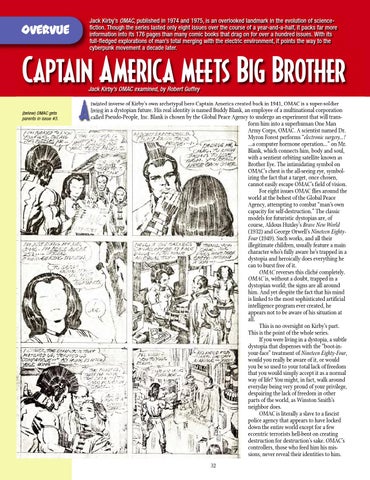Jack Kirby’s OMAC, published in 1974 and 1975, is an overlooked landmark in the evolution of sciencefiction. Though the series lasted only eight issues over the course of a year-and-a-half, it packs far more information into its 176 pages than many comic books that drag on for over a hundred issues. With its full-fledged explorations of man’s total merging with the electric environment, it points the way to the cyberpunk movement a decade later.
Overvue
Captain America meets Big Brother Jack Kirby’s OMAC examined, by Robert Guffey
(below) OMAC gets parents in issue #3.
A
twisted inverse of Kirby’s own archetypal hero Captain America created back in 1941, OMAC is a super-soldier living in a dystopian future. His real identity is named Buddy Blank, an employee of a multinational corporation called Pseudo-People, Inc. Blank is chosen by the Global Peace Agency to undergo an experiment that will transform him into a superhuman One Man Army Corps, OMAC. A scientist named Dr. Myron Forest performs “electronic surgery...! ...a computer hormone operation...” on Mr. Blank, which connects him, body and soul, with a sentient orbiting satellite known as Brother Eye. The intimidating symbol on OMAC’s chest is the all-seeing eye, symbolizing the fact that a target, once chosen, cannot easily escape OMAC’s field of vision. For eight issues OMAC flies around the world at the behest of the Global Peace Agency, attempting to combat “man’s own capacity for self-destruction.” The classic models for futuristic dystopias are, of course, Aldous Huxley’s Brave New World (1932) and George Orwell’s Nineteen EightyFour (1949). Such works, and all their illegitimate children, usually feature a main character who’s fully aware he’s trapped in a dystopia and heroically does everything he can to burst free of it. OMAC reverses this cliché completely. OMAC is, without a doubt, trapped in a dystopian world; the signs are all around him. And yet despite the fact that his mind is linked to the most sophisticated artificial intelligence program ever created, he appears not to be aware of his situation at all. This is no oversight on Kirby’s part. This is the point of the whole series. If you were living in a dystopia, a subtle dystopia that dispenses with the “boot-inyour-face” treatment of Nineteen Eighty-Four, would you really be aware of it, or would you be so used to your total lack of freedom that you would simply accept it as a normal way of life? You might, in fact, walk around everyday being very proud of your privilege, despairing the lack of freedom in other parts of the world, as Winston Smith’s neighbor does. OMAC is literally a slave to a fascist police agency that appears to have locked down the entire world except for a few eccentric terrorists hell-bent on creating destruction for destruction’s sake. OMAC’s controllers, those who feed him his missions, never reveal their identities to him. 32
